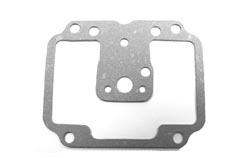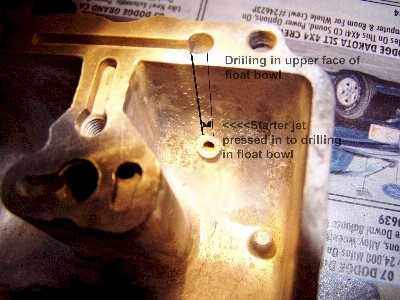In 1974, the L model included an upgrade from simple round slide carburetors to more sophisticated Constant Velocity CV carbs called BS40. Although that sounds like a huge increase in bore from 32mm to 40mm, in fact the flow rates were comparable on both. The BS40 has butterfly valve type throttle which creates considerable flow resistance and the throat is also restrictive.
Starting circuit
The starting circuit is a tad more complex than most other carbs of the time and that leads to misunderstanding and incorrect problem solving.
In principal it is the same enriching circuit as a VM, but the implementation is more complex. Fuel is drawn up from a small drilling in the front face of the bottom of the float bowl and it passes through a tiny (0.6mm) jet pressed into a vertical drilling in the front face of the float bowl. Many owners miss cleaning that jet.
|
|
|
|
|
The schematic on the left shows the starter circuit clearly. In a Mikuni BS40 carburetor, that small starter jet is pressed into place and is hard to clean, but it is essential to clean it properly. |
Air Jets
On the air cleaner side of the carb, there are 3 air jets, all of which can become partially or completely blocked.
The left jet in this position is the main air jet and is only 0.5mm in diameter. It feeds air through drillings down to the float bowl where it mixes with the fuel in the needle jet.
The center drilling allows air to mix with the air/fuel mix as it exits the needle jet, to form smaller droplets to aid in more complete combustion.
The air jet on the right is the Pilot or slow air jet and supplies air to the slow jet which is also fitted into the float bowl. just in front of the main jet.
Fuel Jets
One of the many interesting features of the BS40 carburetor is that the slow jet, main jet, needle jet and starter jet are all fitted to the float bowl and are fed fuel from cross drillings in the bottom of the float bowl. The slow jet looks very similar to those fitted in any Mikuni slide carburetor, but they are actually quite different.
Pilot (slow) Jets
The slow (pilot) jets are known as a BS30/96 and have three cross drilled holes. Normal pilot jets (VM22/210) have 4 pairs and the difference in fuel flow is significant. Always check that the right type of pilot jets are fitted. The significant difference is that the BS jet meters the air and fuel mix after they mix, whereas a VM meters only fuel. For a given jet size, the VM jet will allow much more fuel to pass and that increases more on a VM at higher revs than a BS jet.
To identify a Mikuni Pilot jet, take a short length of wire and slide it gently into the jet. If it stops close to the threads, it's a VM and if it stops close to the other end, it's a BS.
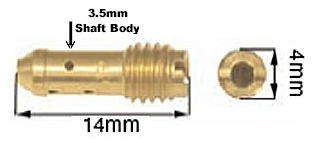 |
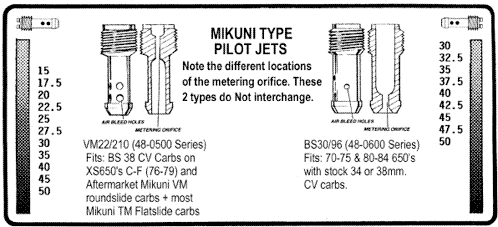 |
| The cross section to the
right came from the Carburetor Manual published by Suzuki in
1974.
The important thing for us to be aware of is the long and torturous path that the pilot air and fuel travel which is prone to clogging. The second thing to note is that the adjusting screw is close to the cylinder and modulates the amount of fuel-air mixture allowed in. Unlike normal carburetors, the adjusting screw is adjusted in to make the mixture more lean and it is screwed out to make the mixture richer.
|
 |
Main Jet
Unlike most slide carburetors, the main jet screws into the base of the float bowl and the slow jet screws into the top of the float bowl and not into the base of the needle jet. This detail came from SUDCO, the US Mikuni importers. Use only genuine Mikuni jets.
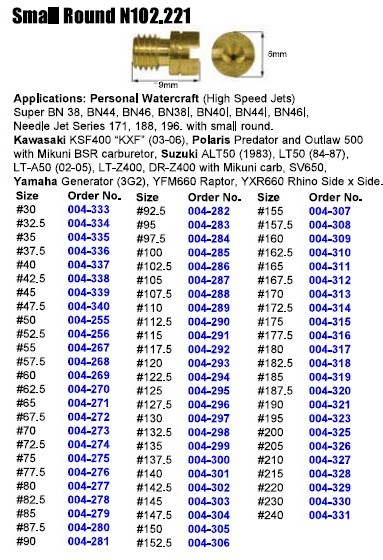
 |
Needle Jet & Jet
Needle
The needle jet is held in place by the float bowl and has a tiny O ring at the top which should be replaced if it's hard or flattened. They are still available from Suzuki and are inexpensive. They are also available from MikesXS The jet is not one of the normal aftermarket series and different sizes are hard to find. They are size Z-0 which is 3.15mm and the only alternate we found is a Z-6 (3.18mm) for the 74-75 Yamaha XS650. From what we have measured so far, it looks like it will work. The sizes, Z-0 and Z-6 are the normal Mikuni needle jet sizing, but are larger than the usual P-0 or Q-4 we're used to seeing. They follow the same size rules though. The needle is 4DN18 and measurements so far suggest that XS650 75-75 needle (4N8) might be slightly richer. The taper is different but it seems to be very similar but equivalent to 3 clip positions more rich. 4N8 Needle and Z-6 needle jets are available from MikesXS.They are marked as genuine Mikuni parts and looks like they would work. They are for the 74-75 Yamaha XS650 which is fitted with BS38 carbs which are very similar. |
Surging
Surging on large capacity two strokes is a common design problem. With the BS40 carbs, Suzuki had hoped that surging would not be a probelm, but unfortunately many bikes still surged at low throttle openings.
The fix was described in a Suzuki Service Bulletin and is quite simple. The passageway in front of the pilot air jet is tapped to take a screw in Mikuni air jet - the same type as all VM series carbs. Part number is BS30/97. The new air jet is either 0.8mm or 0.9mm depending upon model and effectively changes the fuel slope across the pilot jet. Order from SUDCO or your local Mikuni supplier.
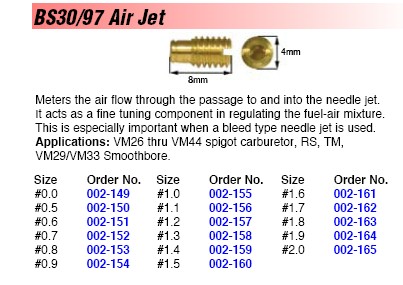 |
At idle, there is no change in fueling, so it works just the same as before the modification. At higher revs on a closed throttle, it richens the mixture enough to eliminate that lean surge condition. The way it works is that on overrun or at a steady at say 3,000 on a closed throttle, the motor creates a relatively strong vacuum which on a stock motor, pulls in too much air via the air jet and it creates a lean surge.
By restricting the air jet slightly it causes the mixture to become slightly richer under those conditions. At idle, the vacuum in the carb is much lower, so the change does not really affect idle or slow running.
Gaskets
Float Bowl gaskets are available from MikeXS
part 20-7029
